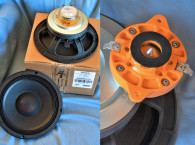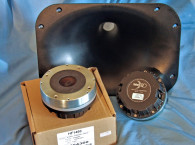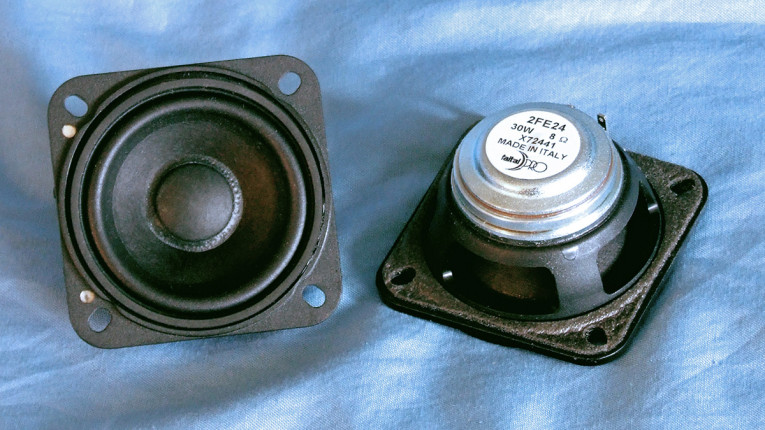
With that as inspiration, I received a 2.5” driver for this Test Bench explication. From FaitalPRO, I got a new 2.5” paper cone full-range, the 2FE24 (Photo 1). Faital has a long history in both the automotive and pro sound speaker markets since 1958. The company is headquartered in San Donato Milanese, Italy, and has manufacturing facilities in Chieve, Italy, and Salgotarian, Hungary.
In terms of features, the 2.5” 2FE24 full-range is built on a proprietary injection-molded polycarbonate four-spoke frame. The cone assembly consists of an uncoated paper cone, with a 20mm diameter paper dust cap, and suspended with a low loss half-roll NBR surround and a 40mm diameter elevated cloth spider (damper). Powering the cone assembly is a neodymium ring magnet (Photo 2) and a milled return cup fitted to a 19mm diameter voice coil wound with aluminum wire on a Kapton former. Tinsel leads connect on one side of the cone to a pair of solderable terminals.
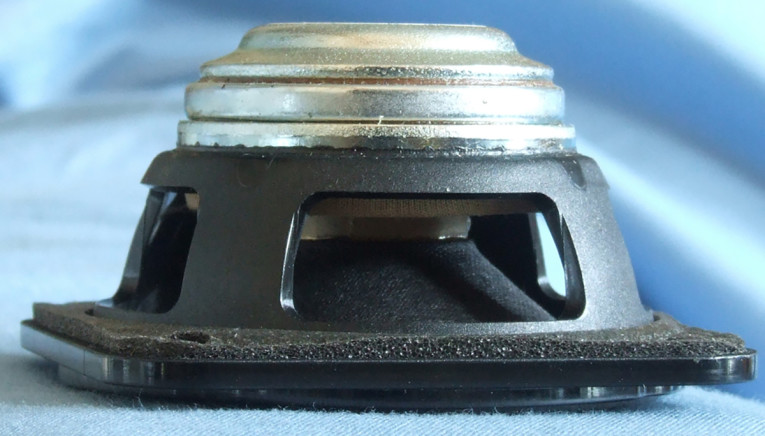
I began testing the FaitalPRO full-range using the LinearX LMS analyzer and the Physical Lab IMP Box. Please note that the Physical Lab IMP Box does current and voltage measurements exactly the same as the LinearX VI Box, however, the LinearX VI Box is no longer available. This IMP Box was used to create both voltage and admittance (current) curves with the driver clamped to a rigid test fixture in free-air at 0.3V, 1V, 3V, and 6V. The 6V curves remained linear enough for LEAP 5 Enclosure Shop to get a good curve fit, which is impressive for a this small a diameter driver.
As has become the protocol for Test Bench testing, I no longer use a single added mass measurement and instead used actual measured mass, the manufacturer’s measured Mmd data (1.8 grams). Next, I post-processed the eight 550-point stepped sine wave sweeps for each of the 2FE24 samples and divided the voltage curves by the current curves (admittance) to produce the impedance curves, phase generated by the LMS calculation method. I imported the data, along with the accompanying voltage curves, to the LEAP 5 Enclosure Shop software.
Since most Thiele-Small (T-S) data provided by OEM manufacturers is being produced using either a standard driver model or the LEAP 4 TSL model, I additionally created a LEAP 4 TSL model using the 1V free-air curves. I selected the complete data set, the multiple voltage impedance curves for the LTD model, and the 1V impedance curve for the TSL model in the transducer derivation menu in LEAP 5 and created the parameters for the computer box simulations. Figure 1 shows the 1V free-air impedance curve. Table 1 compares the LEAP 5 LTD and TSL data and factory parameters for both of the Faital Pro samples.


The LEAP TSL/LTD parameter calculation results for the 2FE24 was reasonably close to the factory data, given the factory data was based on a somewhat less conservative Sd number and a different formula for Xmax. As with many manufacturers today, they prefer to include some fringe field into the Xmax number, instead just the physical Xmax number. Specifically, FaitalPRO uses Xmax= (winding height - gap height)/2 + (gap height/3).
Following my usual protocol, I configured computer enclosure simulations using the LEAP LTD parameters for Sample 1. This consisted of a 28in3 sealed box with 50% damping material (fiberglass), and a 50in3 Chebychev/Butterworth vented enclosure tuned to 107Hz with 15% damping material in the box.
Figure 2 displays the results for the FaitalPRO 2.5” full-range driver in the sealed and vented box simulations at 2.83V and at a voltage level sufficiently high enough to increase cone excursion to Xmax + 15% (0.86mm for the 2FE24). This produced a F3 frequency of 195Hz (F6=166Hz) with a Qtc=1.0 for the 28in3 sealed enclosure and –3dB=159 Hz (F6=107Hz for the 28.7in3 Chebychev/ Butterworth vented simulation. Increasing the voltage input to the simulations until the maximum linear cone excursion was reached resulted in 90dB at 5.2V for the sealed enclosure simulation and 92dB for the same 5.2V input level for the Chebychev/Butterworth vented enclosure. Figure 3 shows the 2.83V group delay curves. Figure 4 shows the 5.2V excursion curves. As usual, a steep high-pass filter on the vented enclosure would prevent over excursion at higher voltage levels.

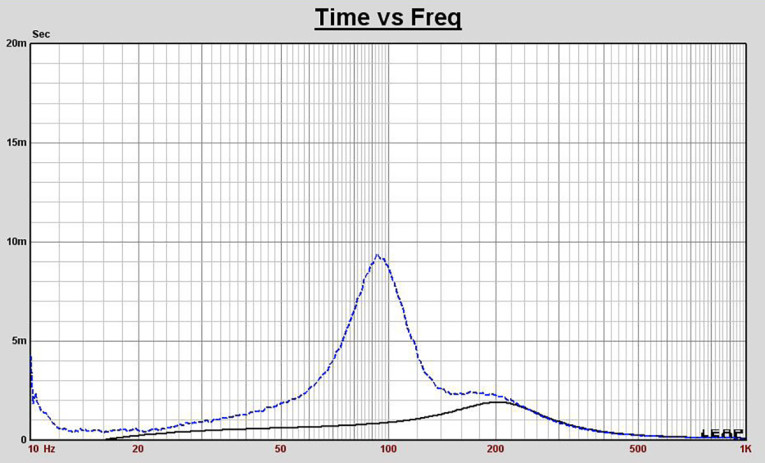

Klippel analysis for the FaitalPRO 2FE24, provided courtesy of Warkwyn, using the KA3 analyzer produced the Bl(X), Kms(X), and Bl and Kms symmetry range plots given in Figures 5–8. The Bl(X) curve for the 2FE24 (Figure 5) is actually fairly symmetrical but with a high percentage of offset, it rather difficult to see that. Looking at the Bl symmetry range curve (Figure 6), excursion remains mostly constant at 0.54mm to beyond the physical Xmax of the driver; however with an Xmax of only 0.75mm, this is a very large percentage.
Putting this in perspective, having the voice coil centered exactly on this small a transducer takes a high amount of precision and normal tolerance is likely not much less than ± 0.5mm. If you were using 32 2FE24 in a line array (the number used in a Bose L1 Pro32) with a DSP high-pass filter set at 200Hz, there would be very limited excursion per each individual driver, so I don’t think this is a concerning issue.

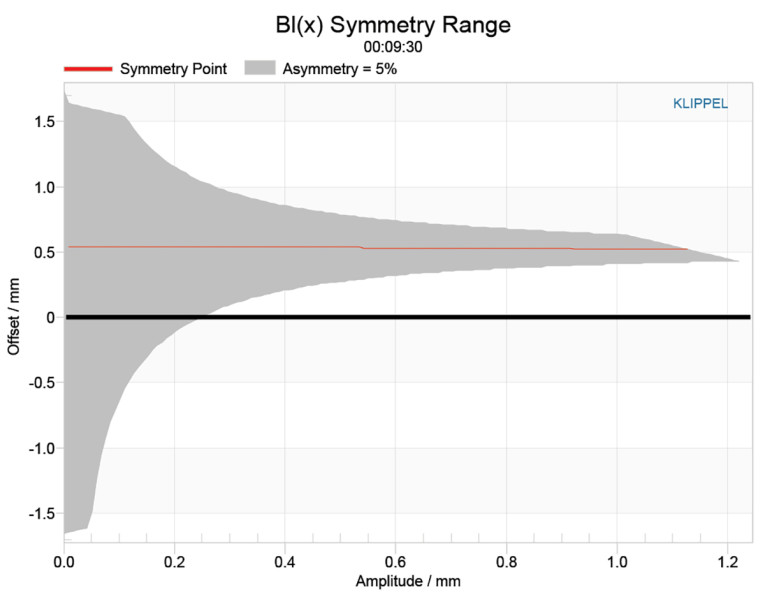
Figure 7 and Figure 8 show the Kms(X) and Kms symmetry range curves for the 2FE24 full-range driver. The Kms(X) curve (Figure 7) is likely rather symmetrical, but with the high percentage of offset, it is difficult to judge. Looking at the Kms symmetry range curve (Figure 8), there is about 0.085mm forward offset at the physical Xmax position, which is actually greater than the 0.75mm Xmax.


Displacement limiting numbers calculated by the Klippel KA3 analyzer for the Faital Pro full-range driver were XBl @ 82% Bl is 0.95mm and for XC @ 75% Cms minimum was 1.24mm, which means that for this woofer, compliance is the most limiting factor for prescribed distortion level of 10%. But again, looking at the typical line array application, excursion induced distortion should not be an issue.
Figure 9 gives the inductance curve Le(X) for the. Inductance will typically increase in the rear direction from the zero rest position as the voice coil covers more pole area, which is what happens with the 2FE234. However the inductance variation is only 0.024mH to 0.020mH from the in and out Xmax positions, which is very minimal.
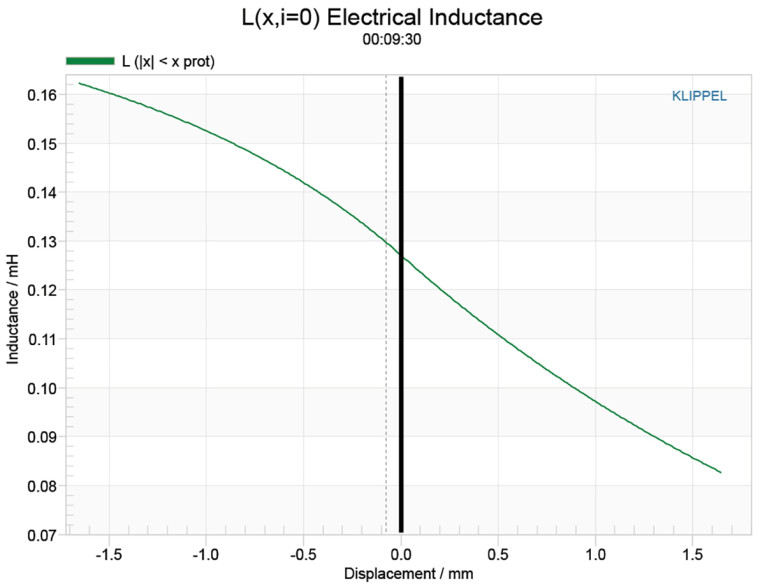
Next I mounted the 2FE24 full-range in an enclosure that had a 9" × 4" baffle and was filled with damping material (foam). Then, I measured the transducer on- and off-axis from 300Hz to 40kHz frequency response using the Loudsoft FINE R+D analyzer and the GRAS 46BE microphone (courtesy of Loudsoft and GRAS Sound & Vibration) both on- and off-axis from at 2.0V/0.5m normalized to 2.83V/1m, using the cosine windowed FFT method. All of these SPL measurements also included a 1/6 octave smoothing, which approximate the 100-point frequency response resolution I used with the LinearX LMS gated sine wave analyzer for a number of years.
Figure 10 gives the FaitalPRO 2.5” driver’s on-axis frequency response, which yields a smooth rising response from 300 Hz to 13 kHz. The response extends out to 30kHz with a broad 10dB peak centered on about 20kHz. Figure 11 displays the on- and off-axis frequency response at 0°, 15°, 30°, and 45°, exhibiting a normal increase in directivity for this 2.5” diaphragm. Figure 12 gives the Figure 11 off-axis curves normalized to the on-axis response. Figure 13 shows the CLIO 180° polar plot (measured in 10° increments). The last of the SPL measurements, Figure 14, shows the two-sample SPL comparison, indicating the two samples were closely matched within less than 1dB out to 20kHz.
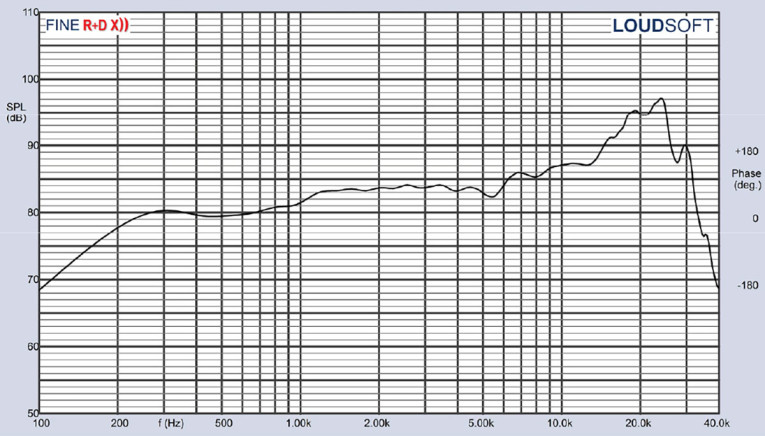


45° = dash/dot)

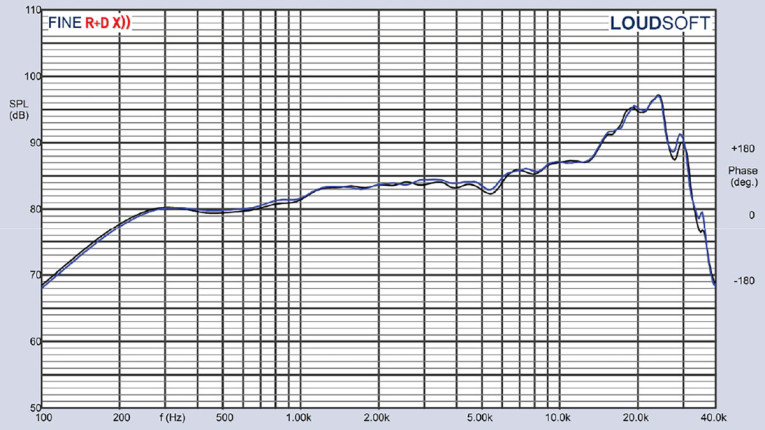
For the remaining series of tests, I employed the Listen, Inc. SoundCheck V18 software, along with the Listen AudioConnect analyzer with the Listen 1/4” SCM microphone and power supply (all courtesy of Listen, Inc.) to measure distortion and generate time-frequency plots. For the distortion measurement, I mounted the FaitalPRO 2.5” full-range driver in free-air, and set the SPL to 94dB at 1m (7.2V), using a noise stimulus. I then measured the distortion with the microphone placed 10cm from the dust cap.
While 94dB/1m is the criteria I use for home audio drivers (and this is technically a pro sound product), this is appropriate for this size transducer, whereas the 104dB pro sound criteria would not at all be appropriate for a single 2.5” transducer. I should also note that if we used the 2FE24 in a 32-driver array, with eight drivers in parallel, and four of these parallel arrays in series, the resulting 4Ω nominal impedance would be have a 103dB/1m sensitivity, which should help put the single driver distortion curve shown in Figure 15 in perspective.
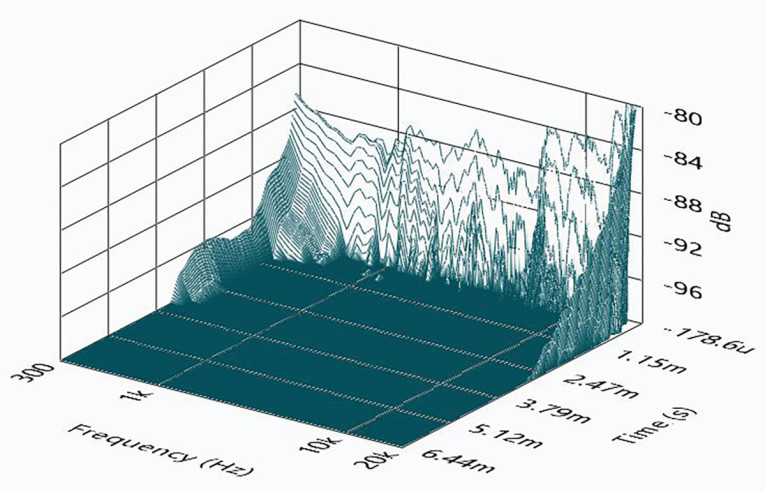
I next employed SoundCheck to get a 2.83V/1m impulse response for this driver and imported the data into Listen’s SoundMap Time/Frequency software. Figure 16 shows the resulting cumulative spectral decay (CSD) waterfall plot. Figure 17 shows the Wigner-Ville plot (chosen for its better low-frequency performance).


Looking over all the above data, the new FaitalPRO 2FE24 should find application in any number of pro sound line array projects. For more information, visit www.faitalpro.com. VC
This article was originally published in Voice Coil, May 2022.




